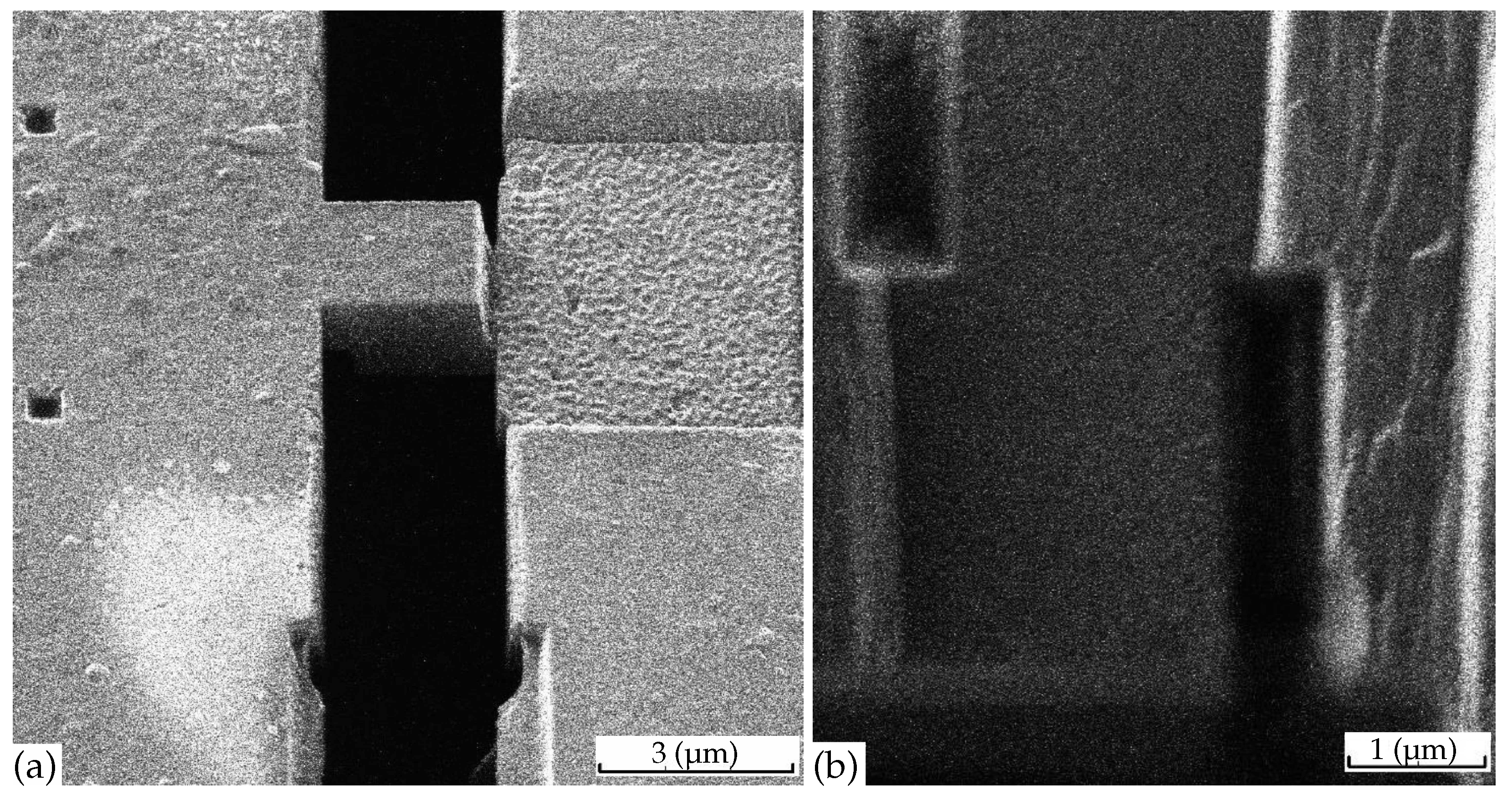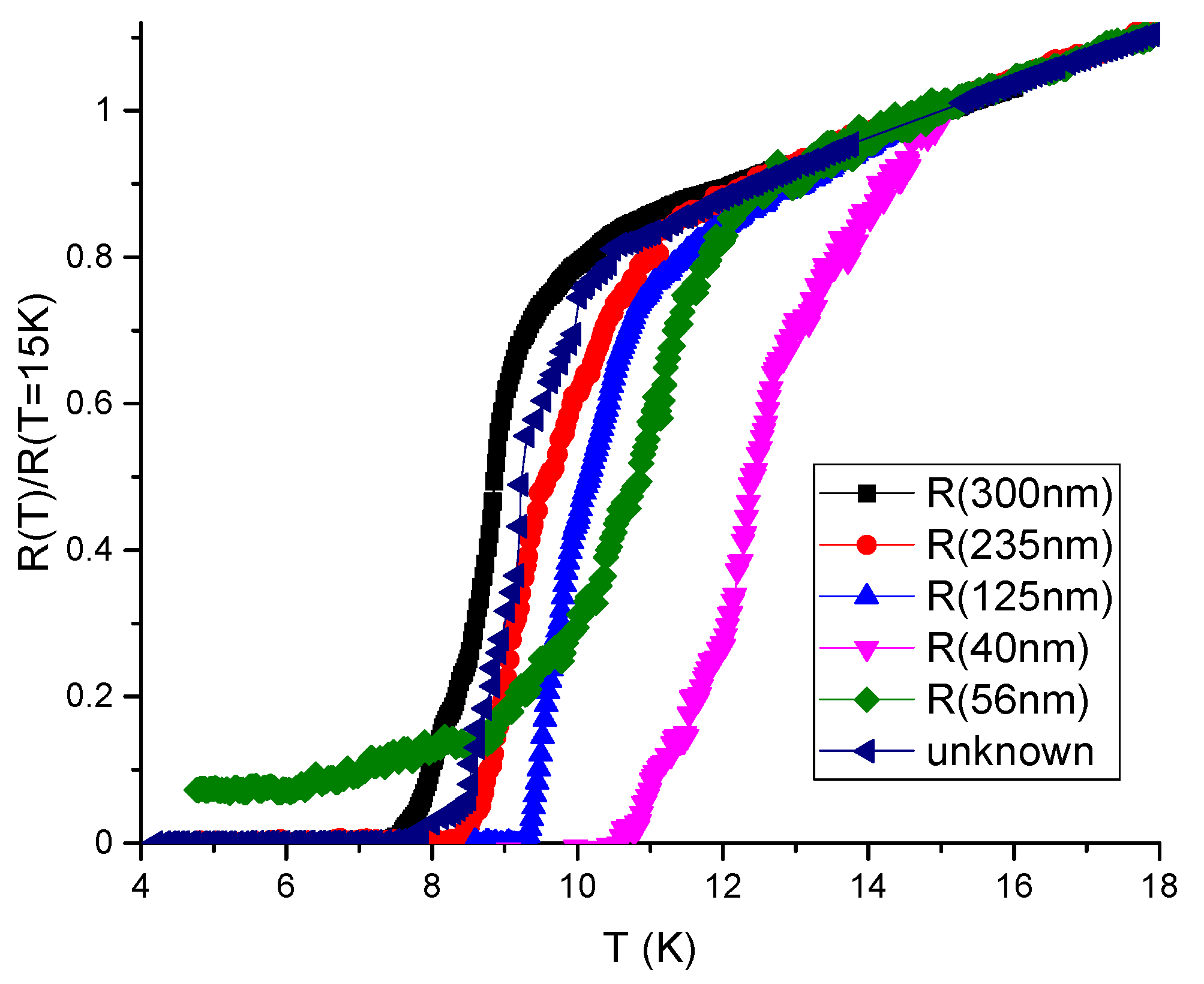Inhomogeneous Superconductivity Onset in FeSe Studied by Transport Properties
Abstract
1. Introduction
2. Materials and Methods
2.1. Experimental
2.2. The Origin of Anisotropic Resistivity Drop above and the Maxwell-Garnett Approximation
2.3. Numerical Calculations of Percolation Threshold
3. Generalization of Maxwell-Garnett Approximation
4. Results
4.1. Experimental
4.2. Preliminary Calculations of Anisotropic Percolation Probability
5. Theoretical Analysis and Discussion
6. Conclusions
Author Contributions
Funding
Institutional Review Board Statement
Informed Consent Statement
Data Availability Statement
Conflicts of Interest
Sample Availability
Abbreviations
| SC | superconductivity |
| FIB | focused ion beam |
| BCS | Bardeen–Cooper–Schrieffer |
| STM | scanning tunneling microscopy |
| STS | scanning tunneling spectroscopy |
| SEM | scanning electron microscopy |
| ARPES | angle-resolved photoemission spectroscopy |
| TB | twin boundaries |
| MGA | Maxwell-Garnett approximation |
References
- Kresin, V.; Ovchinnikov, Y.; Wolf, S. Inhomogeneous superconductivity and the “pseudogap” state of novel superconductors. Phys. Rep. 2006, 431, 231–259. [Google Scholar] [CrossRef]
- Hoffman, J.E. Spectroscopic scanning tunneling microscopy insights into Fe-based superconductors. Rep. Prog. Phys. 2011, 74, 124513. [Google Scholar] [CrossRef]
- Cho, D.; Bastiaans, K.M.; Chatzopoulos, D.; Gu, G.D.; Allan, M.P. A strongly inhomogeneous superfluid in an iron-based superconductor. Nature 2019, 571, 541–545. [Google Scholar] [CrossRef] [PubMed]
- Campi, G.; Bianconi, A. Functional Nanoscale Phase Separation and Intertwined Order in Quantum Complex Materials. Condens. Matter 2021, 6, 40. [Google Scholar] [CrossRef]
- Lang, K.M.; Madhavan, V.; Hoffman, J.E.; Hudson, E.W.; Eisaki, H.; Uchida, S.; Davis, J.C. Imaging the granular structure of high-Tc superconductivity in underdoped Bi2Sr2CaCu2O8+δ. Nature 2002, 415, 412–416. [Google Scholar] [CrossRef]
- Wise, W.D.; Chatterjee, K.; Boyer, M.C.; Kondo, T.; Takeuchi, T.; Ikuta, H.; Xu, Z.; Wen, J.; Gu, G.D.; Wang, Y.; et al. Imaging nanoscale Fermi-surface variations in an inhomogeneous superconductor. Nat. Phys. 2009, 5, 213–216. [Google Scholar] [CrossRef]
- Massee, F.; Huang, Y.; Huisman, R.; de Jong, S.; Goedkoop, J.B.; Golden, M.S. Nanoscale superconducting-gap variations and lack of phase separation in optimally doped BaFe1.86Co0.14As2. Phys. Rev. B 2009, 79, 220517. [Google Scholar] [CrossRef]
- Gofryk, K.; Pan, M.; Cantoni, C.; Saparov, B.; Mitchell, J.E.; Sefat, A.S. Local Inhomogeneity and Filamentary Superconductivity in Pr-DopedCaFe2As2. Phys. Rev. Lett. 2014, 112, 047005. [Google Scholar] [CrossRef]
- Fente, A.; Correa-Orellana, A.; Bohmer, A.E.; Kreyssig, A.; Ran, S.; Budko, S.L.; Canfield, P.C.; Mompean, F.J.; García-Hernández, M.; Munuera, C.; et al. Direct visualization of phase separation between superconducting and nematic domains in Co-doped CaFe2As2 close to a first-order phase transition. Phys. Rev. B 2018, 97, 014505. [Google Scholar] [CrossRef]
- Tanatar, M.A.; Kreyssig, A.; Nandi, S.; Ni, N.; Bud’ko, S.L.; Canfield, P.C.; Goldman, A.I.; Prozorov, R. Direct imaging of the structural domains in the iron pnictides AFe2As2(A = Ca,Sr,Ba). Phys. Rev. B 2009, 79, 180508. [Google Scholar] [CrossRef]
- Song, C.L.; Wang, Y.L.; Jiang, Y.P.; Wang, L.; He, K.; Chen, X.; Hoffman, J.E.; Ma, X.C.; Xue, Q.K. Suppression of Superconductivity by Twin Boundaries in FeSe. Phys. Rev. Lett. 2012, 109, 137004. [Google Scholar] [CrossRef]
- Naidyuk, Y.G.; Fuchs, G.; Chareev, D.A.; Vasiliev, A.N. Doubling of the critical temperature of FeSe observed in point contacts. Phys. Rev. B 2016, 93, 144515. [Google Scholar] [CrossRef]
- Watashige, T.; Tsutsumi, Y.; Hanaguri, T.; Kohsaka, Y.; Kasahara, S.; Furusaki, A.; Sigrist, M.; Meingast, C.; Wolf, T.; Löhneysen, H.v.; et al. Evidence for Time-Reversal Symmetry Breaking of the Superconducting State near Twin-Boundary Interfaces in FeSe Revealed by Scanning Tunneling Spectroscopy. Phys. Rev. X 2015, 5, 031022. [Google Scholar] [CrossRef]
- Bu, K.; Zhang, W.; Fei, Y.; Zheng, Y.; Ai, F.; Wu, Z.; Wang, Q.; Wo, H.; Zhao, J.; Yin, Y. Observation of an electronic order along [110] direction in FeSe. Nat. Commun. 2021, 12, 1385. [Google Scholar] [CrossRef]
- Andres, D.; Kartsovnik, M.V.; Biberacher, W.; Neumaier, K.; Schuberth, E.; Muller, H. Superconductivity in the charge-density-wave state of the organic metal α-(BEDT-TTF)2KHg(SCN)4. Phys. Rev. B 2005, 72, 174513. [Google Scholar] [CrossRef]
- Kang, N.; Salameh, B.; Auban-Senzier, P.; Jerome, D.; Pasquier, C.R.; Brazovskii, S. Domain walls at the spin-density-wave endpoint of the organic superconductor (TMTSF)2PF6 under pressure. Phys. Rev. B 2010, 81, 100509. [Google Scholar] [CrossRef]
- Narayanan, A.; Kiswandhi, A.; Graf, D.; Brooks, J.; Chaikin, P. Coexistence of Spin Density Waves and Superconductivity in (TMTSF)2PF6. Phys. Rev. Lett. 2014, 112, 146402. [Google Scholar] [CrossRef] [PubMed]
- Gerasimenko, Y.A.; Prudkoglyad, V.A.; Kornilov, A.V.; Sanduleanu, S.V.; Qualls, J.S.; Pudalov, V.M. Role of anion ordering in the coexistence of spin-density-wave and superconductivity in (TMTSF)2ClO4. JETP Lett. 2013, 97, 419–424. [Google Scholar] [CrossRef]
- Gerasimenko, Y.A.; Sanduleanu, S.V.; Prudkoglyad, V.A.; Kornilov, A.V.; Yamada, J.; Qualls, J.S.; Pudalov, V.M. Coexistence of superconductivity and spin-density wave in(TMTSF)2ClO4: Spatial structure of the two-phase state. Phys. Rev. B 2014, 89, 054518. [Google Scholar] [CrossRef]
- Haddad, S.; Charfi-Kaddour, S.; Pouget, J.P. Inhomogeneous superconductivity in organic conductors: The role of disorder and magnetic field. J. Phys. Condens. Matter 2011, 23, 464205. [Google Scholar] [CrossRef] [PubMed]
- Naito, T.; Takeda, H.; Matsuzawa, Y.; Kurihara, M.; Yamada, A.; Nakamura, Y.; Yamamoto, T. Organic charge transfer complex at the boundary between superconductors and insulators: Critical role of a marginal part of the conduction pathways. Mater. Adv. 2022, 3, 1506–1511. [Google Scholar] [CrossRef]
- Kamlapure, A.; Das, T.; Ganguli, S.C.; Parmar, J.B.; Bhattacharyya, S.; Raychaudhuri, P. Emergence of nanoscale inhomogeneity in the superconducting state of a homogeneously disordered conventional superconductor. Sci. Rep. 2013, 3, 2979. [Google Scholar] [CrossRef] [PubMed]
- Wang, G.; Raine, M.J.; Hampshire, D.P. How resistive must grain boundaries in polycrystalline superconductors be, to limit Jc? Supercond. Sci. Technol. 2017, 30, 104001. [Google Scholar] [CrossRef]
- Campi, G.; Bianconi, A.; Poccia, N.; Bianconi, G.; Barba, L.; Arrighetti, G.; Innocenti, D.; Karpinski, J.; Zhigadlo, N.D.; Kazakov, S.M.; et al. Inhomogeneity of charge-density-wave order and quenched disorder in a high-Tc superconductor. Nature 2015, 525, 359–362. [Google Scholar] [CrossRef] [PubMed]
- Iguchi, I.; Yamaguchi, T.; Sugimoto, A. Diamagnetic activity above Tc as a precursor to superconductivity in La2-xSrxCuO4 thin films. Nature 2001, 412, 420–423. [Google Scholar] [CrossRef] [PubMed]
- Sugimoto, A.; Iguchi, I.; Miyake, T.; Sato, H. Diamagnetic Precursor State in High-Tc Oxide Superconductors near Optimal Doping Using Scanning Superconducting Quantum Interference Device Microscopy. Jpn. J. Appl. Phys. 2002, 41, L497. [Google Scholar] [CrossRef]
- Rhodes, L.C.; Watson, M.D.; Haghighirad, A.A.; Evtushinsky, D.V.; Kim, T.K. Revealing the single electron pocket of FeSe in a single orthorhombic domain. Phys. Rev. B 2020, 101, 235128. [Google Scholar] [CrossRef]
- McQueen, T.M.; Williams, A.J.; Stephens, P.W.; Tao, J.; Zhu, Y.; Ksenofontov, V.; Casper, F.; Felser, C.; Cava, R.J. Tetragonal-to-Orthorhombic Structural Phase Transition at 90 K in the Superconductor Fe1.01Se. Phys. Rev. Lett. 2009, 103, 057002. [Google Scholar] [CrossRef]
- Rößler, S.; Coduri, M.; Tsirlin, A.A.; Ritter, C.; Cuello, G.; Koz, C.; Muzica, L.; Schwarz, U.; Rößler, U.K.; Wirth, S.; et al. Nematic state of the FeSe superconductor. Phys. Rev. B 2022, 105, 064505. [Google Scholar] [CrossRef]
- Bartlett, J.M.; Steppke, A.; Hosoi, S.; Noad, H.; Park, J.; Timm, C.; Shibauchi, T.; Mackenzie, A.P.; Hicks, C.W. Relationship between Transport Anisotropy and Nematicity in FeSe. Phys. Rev. X 2021, 11, 021038. [Google Scholar] [CrossRef]
- Chuang, T.M.; Allan, M.P.; Lee, J.; Xie, Y.; Ni, N.; Bud’ko, S.L.; Boebinger, G.S.; Canfield, P.C.; Davis, J.C. Nematic Electronic Structure in the ”Parent” State of the Iron-Based Superconductor Ca(Fe1-xCox)2As2. Science 2010, 327, 181–184. [Google Scholar] [CrossRef] [PubMed]
- Sinchenko, A.A.; Grigoriev, P.D.; Orlov, A.P.; Frolov, A.V.; Shakin, A.; Chareev, D.A.; Volkova, O.S.; Vasiliev, A.N. Gossamer high-temperature bulk superconductivity in FeSe. Phys. Rev. B 2017, 95, 165120. [Google Scholar] [CrossRef]
- Grigoriev, P.D.; Sinchenko, A.A.; Kesharpu, K.K.; Shakin, A.; Mogilyuk, T.I.; Orlov, A.P.; Frolov, A.V.; Lyubshin, D.S.; Chareev, D.A.; Volkova, O.S.; et al. Anisotropic effect of appearing superconductivity on the electron transport in FeSe. JETP Lett. 2017, 105, 786–791. [Google Scholar] [CrossRef]
- Seidov, S.S.; Kesharpu, K.K.; Karpov, P.I.; Grigoriev, P.D. Conductivity of anisotropic inhomogeneous superconductors above the critical temperature. Phys. Rev. B 2018, 98, 014515. [Google Scholar] [CrossRef]
- Kochev, V.D.; Kesharpu, K.K.; Grigoriev, P.D. Anisotropic zero-resistance onset in organic superconductors. Phys. Rev. B 2021, 103, 014519. [Google Scholar] [CrossRef]
- Kesharpu, K.K.; Kochev, V.D.; Grigoriev, P.D. Evolution of Shape and Volume Fraction of Superconducting Domains with Temperature and Anion Disorder in (TMTSF)2ClO4. Crystals 2021, 11, 72. [Google Scholar] [CrossRef]
- Mogilyuk, T.I.; Grigoriev, P.D.; Kesharpu, K.K.; Kolesnikov, I.A.; Sinchenko, A.A.; Frolov, A.V.; Orlov, A.P. Excess Conductivity of Anisotropic Inhomogeneous Superconductors Above the Critical Temperature. Phys. Solid State 2019, 61, 1549–1552. [Google Scholar] [CrossRef]
- Chareev, D.; Osadchii, E.; Kuzmicheva, T.; Lin, J.Y.; Kuzmichev, S.; Volkova, O.; Vasiliev, A. Single crystal growth and characterization of tetragonal FeSe superconductors. CrystEngComm 2013, 15, 1989–1993. [Google Scholar] [CrossRef]
- Latyshev, Y.I.; Monceau, P.; Sinchenko, A.A.; Bulaevskii, L.N.; Brazovskii, S.A.; Kawae, T.; Yamashita, T. Interlayer tunnelling spectroscopy of the charge density wave state in NbSe3. J. Phys. Math. Gen. 2003, 36, 9323. [Google Scholar] [CrossRef]
- Frolov, A.V.; Orlov, A.P.; Sinchenko, A.A. House of Cards: Nuances of Fabricating Stable Stacked Junction Structures in Layered Crystals. In Proceedings of the 2019 IEEE International Conference on Manipulation, Manufacturing and Measurement on the Nanoscale (3M-NANO), Zhenjiang, China, 4–8 August 2019; pp. 138–141. [Google Scholar] [CrossRef]
- Hussey, N.E.; Nozawa, K.; Takagi, H.; Adachi, S.; Tanabe, K. Anisotropic resistivity of YBa2Cu4O8: Incoherent-to-metallic crossover in the out-of-plane transport. Phys. Rev. B 1997, 56, R11423–R11426. [Google Scholar] [CrossRef]
- Buravov, L.I.; Kartsovnik, M.V.; Kononovich, P.A.; Laukhin, V.N.; Pesotskii, S.I.; Shchegolev, I.F. The conductivity anisotropy of the quasi-two-dimensional organic metal b-(BEDT-TTF)2I3. Sov. Phys. JETP 1986, 64, 1306. [Google Scholar]
- Tanatar, M.A.; Ni, N.; Thaler, A.; Bud’ko, S.L.; Canfield, P.C.; Prozorov, R. Pseudogap and its critical point in the heavily doped Ba(Fe1-xCox)2As2 from c-axis resistivity measurements. Phys. Rev. B 2010, 82, 134528. [Google Scholar] [CrossRef]
- Tinkham, M. Introduction to Superconductivity, 2nd ed.; International Series in Pure and Applied Physics; McGraw-Hill Inc.: New York, NY, USA, 1996. [Google Scholar]
- Larkin, A.; Varlamov, A. Theory of Fluctuations in Superconductors; Oxford University Press: New York, NY, USA, 2005. [Google Scholar]
- Torquato, S. Random Heterogeneous Materials; Springer: New York, NY, USA, 2002. [Google Scholar] [CrossRef]
- Abdel-Hafiez, M.; Zhang, Y.Y.; Cao, Z.Y.; Duan, C.G.; Karapetrov, G.; Pudalov, V.M.; Vlasenko, V.A.; Sadakov, A.V.; Knyazev, D.A.; Romanova, T.A.; et al. Superconducting properties of sulfur-doped iron selenide. Phys. Rev. B 2015, 91, 165109. [Google Scholar] [CrossRef]
- Wang, C.; Wang, M.; Jiang, J.; Yang, H.; Yang, L.; Shi, W.; Lai, X.; Mo, S.K.; Barinov, A.; Yan, B.; et al. Electronic structure and spatial inhomogeneity of iron-based superconductor FeS. Chin. Phys. B 2020, 29, 047401. [Google Scholar] [CrossRef]






Disclaimer/Publisher’s Note: The statements, opinions and data contained in all publications are solely those of the individual author(s) and contributor(s) and not of MDPI and/or the editor(s). MDPI and/or the editor(s) disclaim responsibility for any injury to people or property resulting from any ideas, methods, instructions or products referred to in the content. |
© 2023 by the authors. Licensee MDPI, Basel, Switzerland. This article is an open access article distributed under the terms and conditions of the Creative Commons Attribution (CC BY) license (https://creativecommons.org/licenses/by/4.0/).
Share and Cite
Grigoriev, P.D.; Kochev, V.D.; Orlov, A.P.; Frolov, A.V.; Sinchenko, A.A. Inhomogeneous Superconductivity Onset in FeSe Studied by Transport Properties. Materials 2023, 16, 1840. https://doi.org/10.3390/ma16051840
Grigoriev PD, Kochev VD, Orlov AP, Frolov AV, Sinchenko AA. Inhomogeneous Superconductivity Onset in FeSe Studied by Transport Properties. Materials. 2023; 16(5):1840. https://doi.org/10.3390/ma16051840
Chicago/Turabian StyleGrigoriev, Pavel D., Vladislav D. Kochev, Andrey P. Orlov, Aleksei V. Frolov, and Alexander A. Sinchenko. 2023. "Inhomogeneous Superconductivity Onset in FeSe Studied by Transport Properties" Materials 16, no. 5: 1840. https://doi.org/10.3390/ma16051840
APA StyleGrigoriev, P. D., Kochev, V. D., Orlov, A. P., Frolov, A. V., & Sinchenko, A. A. (2023). Inhomogeneous Superconductivity Onset in FeSe Studied by Transport Properties. Materials, 16(5), 1840. https://doi.org/10.3390/ma16051840




